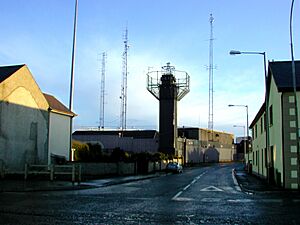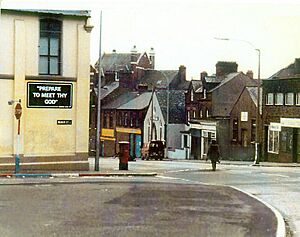Operation Banner facts for kids
Quick facts for kids Operation Banner |
||||||||
|---|---|---|---|---|---|---|---|---|
| Part of the Troubles and the Dissident Irish Republican campaign | ||||||||
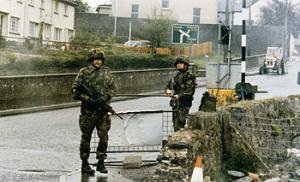 Two British Army soldiers at a checkpoint near Newry, Northern Ireland, 1988 |
||||||||
|
||||||||
| Belligerents | ||||||||
|
|
||||||||
| Commanders and leaders | ||||||||
| Sean MacStiofain Seamus Costello Gerard Steenson |
Gusty Spence Johnny Adair Billy Wright |
|||||||
| Strength | ||||||||
| 21,000 British soldiers 6,500 UDR Total: c. 40,500 |
||||||||
| Casualties and losses | ||||||||
|
PIRA 97 killed by British Army INLA 5 killed by British Army IPLO 1 killed by British Army |
UVF 7 killed by British Army UDA 7 killed by British Army |
||||||
Operation Banner was the name for a long-running military operation by the British Armed Forces in Northern Ireland. It lasted from 1969 to 2007 and was part of a period known as the Troubles. This was the longest continuous deployment in British military history.
The British Army was first sent to Northern Ireland in August 1969. This happened after riots and at the request of the local unionist government. Their main job was to help the Royal Ulster Constabulary (RUC), which was the police force, and to show the British government's authority. This meant they had to deal with rebel groups, keep things safe, guard important places, set up checkpoints, and handle bombs.
More than 300,000 soldiers served in Operation Banner. At its busiest in the 1970s, about 21,000 British troops were there. A new local army group, the Ulster Defence Regiment (UDR), was also formed.
The Provisional Irish Republican Army (IRA) fought against the British military from 1970 to 1997. When the troops first arrived, many Catholics welcomed them because they felt the RUC was unfair. However, feelings changed after events like the Falls Curfew (1970), Operation Demetrius (1971), and Bloody Sunday (1972). There were also times when some British soldiers worked secretly with loyalist groups.
From the late 1970s, the British government started a policy called "Ulsterisation". This meant local forces like the UDR and RUC took on more responsibility. After the Good Friday Agreement in 1998, a peace deal, Operation Banner slowly ended. Most military bases were removed, and many British troops left.
The Ministry of Defence reported that 1,441 British military people died during Operation Banner. Of these, 722 were killed in attacks, and 719 died from other reasons. The worst loss of life for the British military was in the Warrenpoint ambush in 1979.
Contents
What Was Operation Banner?
The British Army was first sent to Northern Ireland in August 1969. This was in response to riots and at the request of the local government. Their main goals were to support the Royal Ulster Constabulary (RUC) and to show the British government's power. The main group fighting against the British military was the Provisional Irish Republican Army (IRA). They fought a guerrilla campaign from 1970 to 1997.
At first, many Catholics welcomed the soldiers in 1969. But this welcome turned into anger after events like the Falls Curfew (1970), Operation Demetrius (1971), the Ballymurphy Massacre (1971), and Bloody Sunday (1972). A British Army document from 2007 said that while they didn't completely defeat the IRA, they made it impossible for the IRA to win through violence. They also helped reduce the number of deaths in the later years of the conflict.
After the Good Friday Agreement in 1998, Operation Banner slowly ended. Army patrols stopped, and many military bases were closed or taken down. This process of reducing military presence, called demilitarisation, began in 1994. After the IRA stopped fighting in 1997, and before they gave up their weapons in 2001, nearly half of the army bases were emptied. Many border roads that had been closed were also reopened.
In August 2005, it was announced that Operation Banner would end by August 1, 2007. This was because the Provisional IRA said their fighting was over. After this date, British troops would only be in Northern Ireland for training. Their numbers would be reduced to 5,000. The police would then be fully in charge of security. The local battalions of the Royal Irish Regiment, which grew from the Ulster Defence Regiment, were stood down in September 2006. The operation officially ended on July 31, 2007, making it the longest British Army operation ever.
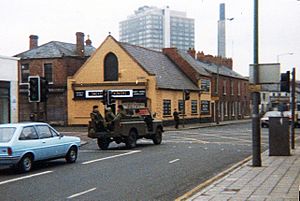
Political parties that wanted a united Ireland, like the Social Democratic and Labour Party and Sinn Féin, welcomed the troops leaving. However, parties that wanted Northern Ireland to stay part of the UK, like the Democratic Unionist Party and Ulster Unionist Party, did not agree. They thought it was too soon. They worried about other rebel groups, losing security jobs for Protestants, and felt the army's presence showed Northern Ireland was part of Britain.
After July 31, 2007, British Army support to the police was greatly reduced. This new, smaller role was called Operation Helvetic. It mainly involved specialized bomb disposal and helping the police in very serious public disorder situations. This marked the end of the British Army's emergency operation in Northern Ireland.
How the Armed Forces Helped
The British Army provided most of the support to the police. The Royal Air Force (RAF) helped by providing helicopters. The Royal Navy and Royal Marines also helped at sea in an operation called Grenada. Their job was to stop weapons from reaching rebel groups. They also showed a strong presence around the coast of Northern Ireland and Lough Neagh.
The army described its role in supporting the police in these ways:
- Routine support: This included protecting police officers during their normal duties in dangerous areas. It also meant patrolling around military and police bases to stop attacks. They also helped with police-led operations against rebel groups.
- Additional support: This was when the police needed more help than they had. It included setting up observation posts along the border. They also provided more help during times of civil disorder. The military could send soldiers to protect police lines and help move police and soldiers. They could also provide heavy machines to remove roadblocks and build barriers.
- Specialist support: This involved special skills like bomb disposal, using search and tracker dogs, and divers from the Royal Engineers.
Number of Soldiers Involved
At its busiest in the 1970s, about 21,000 British soldiers were in Northern Ireland. By 1980, this number dropped to 11,000, and then to 9,000 in 1985. The number went up again to 10,500 in the late 1980s. This was because the IRA started using more homemade bombs. In 1992, there were 17,750 members of all British military forces involved.
The British Army was organized into three brigades, led by a lieutenant-general. Six battalions (large groups of soldiers) stayed for two and a half years. Four other battalions rotated, serving six-month tours. In July 1997, during serious riots, the total number of security forces in Northern Ireland grew to over 30,000, including the RUC police.
Military Vehicles and Equipment
The British military used various vehicles during Operation Banner. Some of these were specially made for the operation. They included:
- Alvis Saracen
- Alvis Saladin
- Ferret armoured car
- Humber Pig
- Saxon
- Land Rovers, including the Snatch Land Rover
- Aérospatiale Gazelle helicopter
- Aérospatiale SA 330 Puma helicopter
- Chinook helicopter
- Westland Lynx helicopter
Casualties and Impact
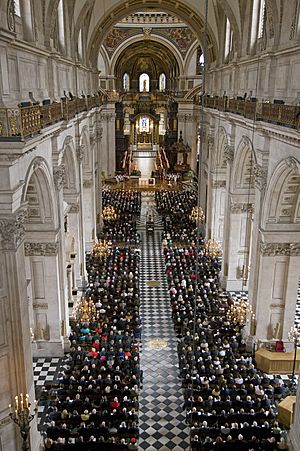
During Operation Banner, 1,441 British military personnel died. This included:
- 814 from the regular British Army; 477 were killed by rebel groups, and 337 died from other causes.
- 548 from the Ulster Defence Regiment/Royal Irish Regiment; 204 were killed by rebel groups, and 344 died from other causes.
- 17 from the Territorial Army; 9 were killed by rebel groups, and 8 died from other causes.
- 26 Royal Marines; 21 were killed by rebel groups, and 5 died from other causes.
- 26 Royal Air Force servicemen; 4 were killed by rebel groups, and 22 died from other causes.
- 8 Royal Navy servicemen; 5 were killed by rebel groups, and 3 died from other causes.
- 2 from other Army branches, who were killed by rebel groups.
Another 45 former British military personnel also died during Operation Banner. In July 2009, it was announced that their families could receive the Elizabeth Cross, a special award.
According to the "Sutton Index of Deaths" from the Conflict Archive on the Internet (CAIN), the British military killed 307 people during Operation Banner. This included:
- 156 civilians (about 51%)
- 128 members of republican rebel groups (about 42%), including:
- 111 from the Provisional Irish Republican Army
- 11 from the Official Irish Republican Army
- 5 from the Irish National Liberation Army (INLA)
- 1 from the Irish People's Liberation Organisation (IPLO)
- 14 members of loyalist rebel groups (about 5%), including:
- 7 from the Ulster Defence Association (UDA)
- 7 from the Ulster Volunteer Force (UVF)
- 6 members of the British Army
- 2 Royal Ulster Constabulary (RUC) officers
- 1 member of the Ulster Defence Regiment (UDR)
Another detailed study, Lost Lives, states that the British military killed 301 people during Operation Banner.
- 160 civilians (about 53%)
- 121 republican rebel group members (about 40%)
- 10 loyalist rebel group members (about 3%)
- 8 fellow British military personnel (about 2%)
- 2 RUC officers


